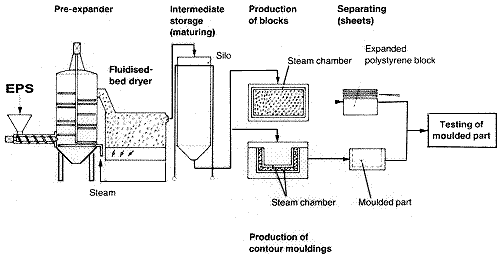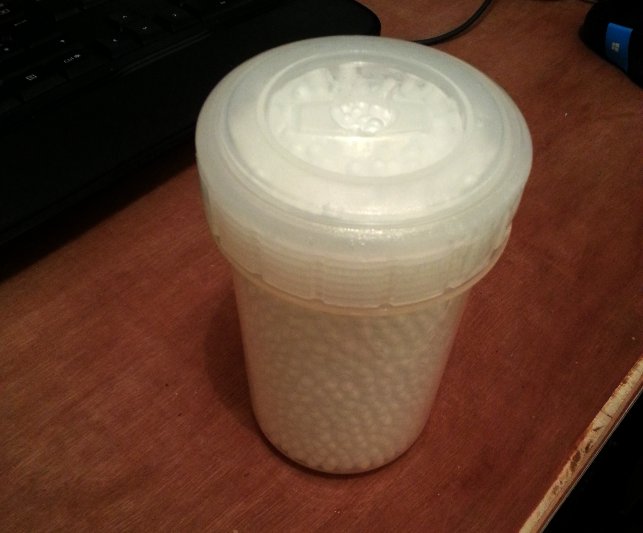Casting expanded polystyrene
 I am currently designing a small desktop rotating speaker, it is basically a miniature version of a rotating polystyrene Leslie baffle that is found in the guts of a cheap 70’s electric organ. I will show some results of this soon but first I want to share an idea about how to DIY mould polystyrene.
I am currently designing a small desktop rotating speaker, it is basically a miniature version of a rotating polystyrene Leslie baffle that is found in the guts of a cheap 70’s electric organ. I will show some results of this soon but first I want to share an idea about how to DIY mould polystyrene.
To make maquettes of the design I have been using 3d printed PLA shapes, I can produce them quite lightweight as 3d printing allows me to them very hollow, but I couldn’t help wondering how to make a polystyrene one. Especially as I think polystyrene is probably more dampening to sound which is ideal for this device that I am making. As a bonus it is also used for the original speaker. I have a CNC so I could carve it out of a machinable foam ( expanded polystyrene is a bit tricky! ) but looking at polystyrene packaging I noticed it is actually moulded in a very similar way to injection moulding.
So what is expanded polystyrene?
Polystyrene is a plastic, basic polystyrene is a pretty hard and brittle, CD jewel cases are typically made from various types of polystyrene. So actually what most people think of as polystyrene is expanded polystyrene (EPS) this is polystyrene that has been made into pellets then aerated and expanded many times its volume. That makes it very lightweight and a great insulator! downside is that it is pretty flammable, so if it is used in building insulation you have to make sure it is flame retarded.
How to cast with it
But how are shapes formed with these pellets? I initially thought that perhaps a machine somehow pushes the beads into a space then compresses it under heat, but experiments with heating a bead or two up showed me they just dissolve back to their original density! Information on the factory process is pretty scarce so after a bit of searching I found this small explanation below of the entire process.

EPS is manufactured from styrene monomer, derivative of ethylene and benzene, using a polymerisation process which produces translucent spherical beads of polystyrene, about the size of sugar granules. During this process a low boiling point hydrocarbon, usually pentane gas, is added to the material to assist expansion during subsequent processing. Beads are delivered to EPS processors usually in boxes of 600kg or 1000kg.
EPS is produced in a three stage process. In the first stage, polystyrene beads are expanded to between 40 and 50 times their original volume by heating to about 100ºC with steam in an enclosed vessel called a pre expander. During this process the beads are stirred continuously. In this process the final density of EPS is determined. This is typically between 14 kg per cubic metre and 30 kg per cubic metre. After pre expansion, the expanded beads are cooled and dried in a fluidised bed drier, before being pneumatically conveyed to storage silos for maturing.
During maturing, the second stage of processing, the expanded beads containing up to 90% air are stabilised typically over a period of 24 hours. Following pre-expansion, the beads have a partial vacuum which must be equalised before final processing by allowing air to diffuse into the beads until equilibrium is reached.
In the third stage of processing, known as the moulding stage, beads are conveyed into a mould, and once in the mould are heated again by the introduction of steam. Under the influence of steam, the beads soften and start to expand again. However, as they are contained in a mould they cannot expand freely, and therefore create an internal pressure within the mould. Under this pressure the softened beads fuse together when the correct temperature is reached within the mould. Following fusion the mould is cooled, usually under the influence of a vacuum to remove moisture. The moulded product is ejected from the mould at the completion of the cycle. During processing, the pentane gas is expended, so that the finished products contain no residual gas.
There are generally two moulding processes for EPS. One is called Block Moulding and produces large blocks of EPS up to 5 metres in length. These are subsequently cut into shapes or sheets for use predominantly in packaging and in construction.
The second moulding process is known as Shape Moulding, and produces shaped parts ready to use in a wide range of applications. Electronic product packaging in particular is where shape moulded EPS is used extensively. Computers, office machines, televisions and stereo equipment are everyday examples.
Source www.plastics.org.nz
So it mentions that there are 2 stages, making the beads and casting the beads. There is no chance I have the ability to process my own polystyrene into EPS, but what if I can get hold of the secondary material? All that seems to happen is steam is injected into a mould, that can’t be hard to re-create! Looking at various Alibaba listings for raw EPS I noticed that the beads sold for straight casting look pretty much like the ones sold for filling bean bags. Could it be that manufacturers just buy pre cast raw EPS and fill bean bags with it? maybe, but perhaps they post-expand the beads for maximum volume and cost? Time for an experiment. I purchased a small bag of EPS beads from ebay, specifically ‘virgin’ beads ( horrible name ) that means they are not recycled broken down cast polystyrene but perhaps straight from the first process?
Experiments

To simulate the casting process I used the following
- Wall paper steamer
- water tight Tupperware container
- ‘virgin’ bean bag beads

Test 1
- I drilled a hole in the top of the container and filled it with the beads all the way to the top.
- Then I waited for the wallpaper steamer to heat up, once to temperature I put it on the hole trying not to scald myself
Success! it held together, well sort of. It didn’t really expand tightly to the sides and only half of it cast, it also breaks apart quite easily. So I thought perhaps I need to drill holes in the bottom to let the steam flow through and not cool and compress more beads inside when I load it up.

Test 2
I drilled holes in the bottom and compressed more beads inside, I also held the steam on for a lot longer. This worked a lot better and I got a solid shape, it still did not cast flat to the surface and water flows right through it , so it is not closed cell like commercial packaging. But this is a lot better and process perhaps I can create a process to mould EPS into shapes.
How can I improve and go further
Thats the end of my experiment for tonight, but I am interested into how to take this further, here are my further research points.
- Looking at moulding stage explanation of Plastics.org.nz I notice it mentions a vacuum perhaps this may help expansion or maybe it just to remove water
- Perhaps my steamer is not hot enough, I will test it with a thermometer
- The EPS material is almost max-expanded, I see a lot of different grades of polystyrene on Ebay, there may be a better one.
- Moulding, how to create a device to allow me to make moulds, it may not need to be metal as temperatures are fairly low, perhaps a high temp plastic might work?